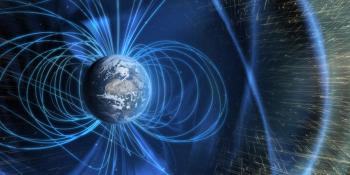Viendo archivo del martes, 29 marzo 2011
Informe actividad solar
Any mentioned solar flare in this report has a scaling factor applied by the Space Weather Prediction Center (SWPC). Because of the SWPC scaling factor, solar flares are reported as 42% smaller than for the science quality data. The scaling factor has been removed from our archived solar flare data to reflect the true physical units.
Informe de actividad Solar-Geofísica 2011 Mar 29 2200 UTCPreparado por NOAA © SWPC y procesado por SpaceWeatherLive.com
Informe conjunto USAF/NOAA de actividad Solar y Geofísica
SDF Número 088 Publicado el 2200Z a las 29 Mar 2011IA. Análisis de regiones solares activas y de actividad desde 28-2100Z hasta 29-2100Z Solar activity remained at low levels. Region 1183
(N15E39) produced a single C1 flare at 29/0515Z, along with several
optical subflares early in the period. Region 1183 showed gradual
spot and penumbral growth through the summary period and was
classified as an Eac group with a beta magnetic configuration.
Region 1176 (S16W24) showed no significant changes during the period
and produced an isolated B-class flare. No new regions were
numbered.
IB. Pronóstico de la actividad solar
Solar activity is expected to be low
during the period (30 March - 01 April) with a chance for an M-class
flare from Region 1183. Old Region 1169 (N17, L=078) is expected to
return to the visible disk late on day 1 (30 March) and may also
provide a chance for an M-class flare.
IIA. Resumen de la actividad geofísica 28-2100Z a 29-2100Z
Geomagnetic activity was at quiet levels. A weak geomagnetic sudden
impulse (SI) occurred at 29/1604Z (8 nT, as measured by the Boulder
USGS magnetometer). The SI likely represented the passage of the
halo-CME observed on 24 March. ACE solar wind data showed increased
velocities (313 to 384 km/s), as well as increases in density (2 to
27 p/cc) and IMF Bt (5 to 9 nT) following the CME passage. IMF Bz
was mostly northward following the passage.
IIB. Pronóstico de la actividad geofísica
Geomagnetic activity is
expected to be at quiet to unsettled levels during the period (30
March - 01 April) with a chance for brief active levels due to
recurrent coronal hole high-speed stream effects.
III. Probabilidades del evento 30 Mar a 01 Apr
| Clase M | 40% | 40% | 40% |
| Clase X | 05% | 05% | 05% |
| Protón | 01% | 01% | 01% |
| PCAF | green | ||
IV. Penticton 10.7cm flujo
Observado 29 Mar 116 Previsto 30 Mar-01 Apr 120/125/130 Media de 90 Días 29 Mar 097
V. Índices Geomagnéticos A
Observado Afr/Ap 28 Mar 002/003 Estimado Afr/Ap 29 Mar 003/005 Previsto Afr/Ap 30 Mar-01 Apr 010/010-010/010-008/008
VI. Probabilidades de Actividad Geomagnética 30 Mar a 01 Apr
| A. Latitudes Medias | |||
|---|---|---|---|
| Activo | 20% | 20% | 15% |
| Tormenta Menor | 05% | 05% | 01% |
| Tormenta Mayor-Severa | 01% | 01% | 01% |
| B. Latitudes Altas | |||
|---|---|---|---|
| Activo | 25% | 25% | 20% |
| Tormenta Menor | 10% | 10% | 05% |
| Tormenta Mayor-Severa | 01% | 01% | 01% |
< < Ir a la visión general diaria
Últimas noticias
Últimos mensajes del foro
Incoming Active Regions 250Geomagnetic storming, CMEs from AR 13664, 2024-05-09/10 1106Traffic record broken!(?) Updated! 9AR3664 788Is there any truth to this "Internet/Electrical Grid Apocalypse"? 144
Más temasApoye a SpaceWeatherLive.com!
Mucha gente viene a SpaceWeatherLive para seguir la actividad del Sol o previsión de aurora, pero con esta cantidad de tráfico se incrementan los costos del servidor. ¡Considere hacer una donación si disfruta de SpaceWeatherLive para que podamos mantener el sitio web en línea!

Hechos clima espacial
| Último evento clase X | 2024/05/11 | X1.5 |
| Último evento clase M | 2024/05/11 | M1.6 |
| Últimas tormentas geomagnéticas | 2024/05/10 | Kp9 (G5) |
| Días sin manchas | |
|---|---|
| Último día sin manchas | 2022/06/08 |
| Promedio de manchas solares mensuales | |
|---|---|
| abril 2024 | 136.5 +31.6 |
| mayo 2024 | 139.8 +3.3 |
| Last 30 days | 170.5 +79.6 |


